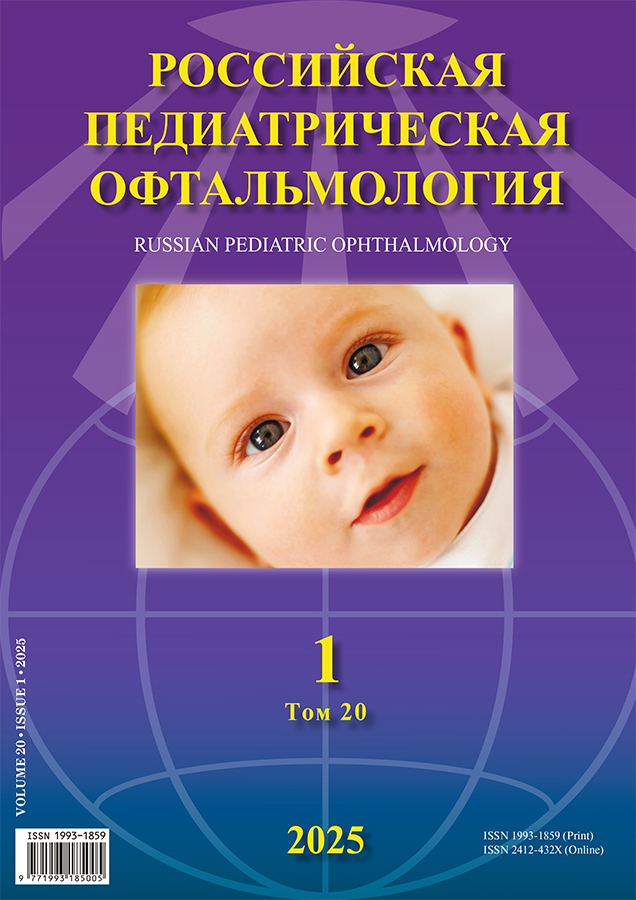Scleral rigid contact lenses in vision rehabilitation of pediatric patients with injury-related corneal scarring
- Authors: Ivanova A.V.1, Sklyarova A.S.1, Khandzhyan A.T.1, Khodzhabekyan N.V.1, Manukyan I.V.1
-
Affiliations:
- Helmholtz National Medical Research Center of Eye Diseases
- Issue: Vol 20, No 1 (2025)
- Pages: 35-41
- Section: Case reports
- Published: 29.04.2025
- URL: https://ruspoj.com/1993-1859/article/view/642729
- DOI: https://doi.org/10.17816/rpoj642729
- EDN: https://elibrary.ru/COPJKB
- ID: 642729
Cite item
Abstract
Eye injuries in children are one of the leading causes of blindness and early disability associated with developmental delay. Scleral rigid contact lenses represent an effective method of vision correction in patients with corneal irregularities. Scleral lenses improve visual acuity and reduce aberrations by providing a more regular anterior corneal surface with the aqueous layer forming between the lens and the cornea.
AIM: To study the specifics of correction with personalized scleral rigid contact lenses in vision rehabilitation in pediatric patients with injury-related corneal scarring.
RESULTS: The paper presents with case reports in which personalized scleral rigid contact lenses were required to be fitted for children with injury-related corneal scarring. The ophthalmological examination included visometry, autorefractometry, biomicroscopy, Scheimpflug imaging with Galilei G6, optical coherence tomography of the cornea with Anterion, and aberrometry with OPD-Scan III. In all cases, the scleral lenses were fitted with a personalized approach. Highly positive refractory and vision outcomes were obtained. All patients were more than satisfied with the functional outcomes, tolerability, and adaptation to the lenses.
CONCLUSION: Scleral lenses may be used in pediatric patients with injury-related corneal scarring in order to improve vision functions, reduce aberrations, and restore binocular vision. In most cases, this method of contact correction is the only one to achieve better vision acuity in children with injury-related corneal scarring.
Full Text
About the authors
Anastasiya V. Ivanova
Helmholtz National Medical Research Center of Eye Diseases
Author for correspondence.
Email: Nastya911@list.ru
ORCID iD: 0000-0002-2548-5900
MD, Cand. Sci. (Medicine)
Russian Federation, MoscowAnna S. Sklyarova
Helmholtz National Medical Research Center of Eye Diseases
Email: doctorsklyarova@mail.ru
ORCID iD: 0009-0002-7069-3693
MD, Cand. Sci. (Medicine)
Russian Federation, MoscowAnush T. Khandzhyan
Helmholtz National Medical Research Center of Eye Diseases
Email: a_khanjian@mail.ru
ORCID iD: 0000-0002-5674-2869
MD, Cand. Sci. (Medicine)
Russian Federation, MoscowNarine V. Khodzhabekyan
Helmholtz National Medical Research Center of Eye Diseases
Email: narin27@mail.ru
ORCID iD: 0000-0002-4998-7323
MD, Cand. Sci. (Medicine)
Russian Federation, MoscowInessa V. Manukyan
Helmholtz National Medical Research Center of Eye Diseases
Email: innamanukyan@yandex.ru
ORCID iD: 0009-0003-6558-3200
MD, Cand. Sci. (Medicine)
Russian Federation, MoscowReferences
- Shoja MR, Miratashi AM. Pediatric ocular trauma. Acta Med Iran. 2006;44(2):125–130. doi: 10.18231/j.ijooo.2022.038
- Kuhn F, Morris R, Mester V, et al. Epidemiology and socioeconomics. Ophthalmol Clin North Am. 2002;15(2):145–151. doi: 10.1016/s0896-1549(02)00005-6
- Avetisov SE, Aklayeva NA, At'kova EL, et al. Ophthalmology: national manual. Avetisov SE, editor. Moscow: GEOTAR-Media; 2008. 1017 р. (In Russ.)
- Rykov SA, Tumanova OV, Goncharuk DV. Analysis of severe eye trauma in children. Ukrainian Medical Journal. 2012;(4):12–18. (In Russ.)
- Tomazzoli L, Renzi G, Mansoldo C. Eye injuries in childhood: a retrospective investigation of 88 cases from 1988 to 2000. Eur J Ophthalmol. 2003;13(8):710–713. doi: 10.1177/112067210301300808
- Serrano JC, Chalela P, Arias JD. Epidemiology of childhood ocular trauma in a northeastern Colombian region. Arch Ophthalmol. 2003;121(10):1439–1445. doi: 10.1001/archopht.121.10.1439
- Vasnaik A, Vasu U, Battu RR, et al. Mechanical eye (globe) injuries in children. J Pediatr Ophthalmol Strabismus. 2002;39(1):5–10; quiz 39-40. doi: 10.3928/0191-3913-20020101-04
- Kaur A, Agrawal A. Paediatric ocular trauma. Current Science (India). 2005;89(1):43–46.
- MacEwen CJ, Baines PS, Desai P. Eye injuries in children: the current picture. Br J Ophthalmol. 1999;83(8):933–936. doi: 10.1136/bjo.83.8.933
- Yan P, Kapasi M, Conlon R, et al. Patient comfort and visual outcomes of mini-scleral contact lenses. Can J Ophthalmol. 2017;52(1):69–73. doi: 10.1016/j.jcjo.2016.07.008
- Macedo-de-Araújo RJ, Faria-Ribeiro M, McAlinden C, et al. Optical quality and visual performance for one year in a sample of scleral lens wearers. Optom Vis Sci. 2020;97(9):775–789. doi: 10.1097/OPX.0000000000001570 EDN: QMTVBC
- Schornack M, Nau C, Nau A, et al. Visual and physiological outcomes of scleral lens wear. Cont Lens Anterior Eye. 2019;42(1):3–8. doi: 10.1016/j.clae.2018.07.007
- Otchere H, Jones L, Sorbara L. The impact of scleral contact lens vault on visual acuity and comfort. Eye Contact Lens. 2018;44(Suppl 2):S54–S59. doi: 10.1097/ICL.0000000000000427
- Piñero Llorens DP. Managing irregular cornea with scleral contact lenses. Ophthalmology Times. 2019;44(5).
- Eguileo BL, Ecenarro JE, Carro AS, Lera RF. Irregular corneas: improve visual function with scleral contact lenses. Eye Contact Lens. 2018;44(3):159–163. doi: 10.1097/ICL.0000000000000340
- Namrata S, Sah R, Priyadarshini K, Titiyal JS. Contact lenses for the treatment of ocular surface diseases. Indian J Ophthalmol. 2023;71(4):1135–1141. doi: 10.4103/IJO.IJO_17_23 EDN: RXSDTL
Supplementary files















